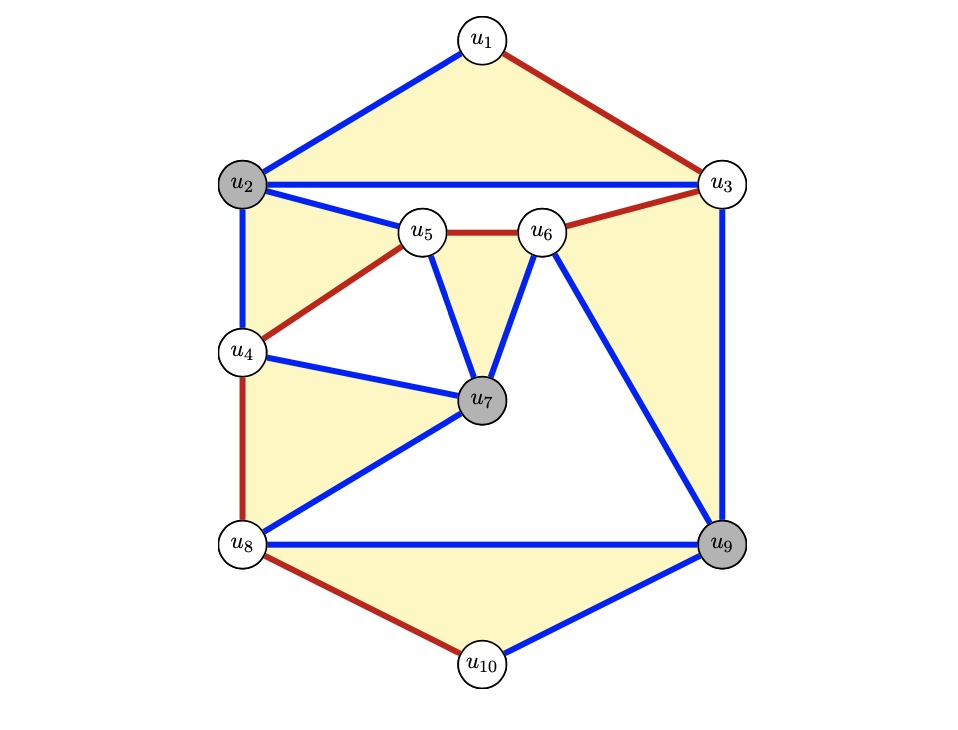Scientists Disprove Bunkbed Conjecture

Mathematicians from Russia, including two HSE graduates, have disproven a well-known mathematical conjecture that, despite lacking solid proof, had been considered valid for 40 years. The ‘Bunkbed Conjecture’ belongs to percolation theory—a branch of mathematics that studies the formation of connected structures in independent environments.
The hypothesis was proposed in the 1980s by Dutch physicist Pieter Kasteleyn, who aimed to mathematically describe how liquids seep through porous surfaces, such as water saturating a sponge.
The conjecture is based on random connections between vertices in an imaginary graph resembling a bunkbed. It posits that the probability of a connection forming between two vertices on the same level is higher than the probability of a connection forming between levels.

While this statement seems intuitively true, no convincing proof had been found to confirm or refute it until recently. Sceptics argued that the claim was too general to hold true in all cases.
Mathematics typically focuses on proving the validity of statements, with disproofs being relatively rare. However, a team of Russian mathematicians—Igor Pak, Nikita Gladkov, and Aleksandr Zimin—managed to find a counterexample that invalidated the conjecture.
‘Actually, my colleague Nikita Gladkov and I first encountered the “bunkbed” concept during our freshman year at HSE. We were dorm roommates, and our room actually had a bunkbed,’ joked Aleksandr Zimin. ‘With this conjecture, we understood that it holds true for most cases. But we were curious—are there rare cases where it fails?’
Initially, the team tried to find a counterexample using machine learning methods. They trained a neural network to identify potential connections in graphs and attempted to explore all possible configurations. However, for graphs with more than nine vertices, the number of possible connections grew exponentially, quickly exceeding computational limits. No proof was found.
The researchers then adapted methods from hypergraph theory, where a disproof of the Bunkbed Conjecture already existed, to classical graphs. They constructed a highly complex structure containing thousands of vertices and edges. In this graph, the probability of a connection forming between the upper and lower levels was slightly higher than the probability of a connection forming on the lower level, thereby disproving the conjecture.

‘My co-authors Igor Pak and Nikita Gladkov—who are currently working at UCLA—and I complemented each other perfectly on this project. I prefer using numerical methods. In my opinion, to truly understand a problem, you need to be able to program it and explain it to a computer. Nikita, on the other hand, takes a different approach and prefers relying on a more abstract, intuitive level,’ says Aleksandr Zimin, one of the authors of the paper and a postgraduate student at the HSE Faculty of Mathematics.

Aleksandr Zimin
‘The conjecture resisted disproof for a long time—or perhaps no one wanted to disprove it because it was beautiful and elegant. However, in my view, disproving it does not destroy its beauty; rather, it proves that the world is far more interesting and complex than we thought,’ Zimin says.
The discovered counterexample raises fundamental questions for science about whether intuition can be relied upon, how critical thinking should be applied in mathematics, and how probabilistic evidence-based proofs should be interpreted.
Alexander Zimin
See also:
New Method for Describing Graphene Simplifies Analysis of Nanomaterials
An international team, including scientists from HSE University, has proposed a new mathematical method to analyse the structure of graphene. The scientists demonstrated that the characteristics of a graphene lattice can be represented using a three-step random walk model of a particle. This approach allows the lattice to be described more quickly and without cumbersome calculations. The study has been published in Journal of Physics A: Mathematical and Theoretical.
Scientists Have Modelled Supercapacitor Operation at Molecular and Ionic Level
HSE scientists used supercomputer simulations to study the behaviour of ions and water molecules inside the nanopores of a supercapacitor. The results showed that even a very small amount of water alters the charge distribution inside the nanopores and influences the device’s energy storage capacity. This approach makes it possible to predict how supercapacitors behave under different electrolyte compositions and humidity conditions. The paper has been published in Electrochimica Acta. The study was supported by a grant from the Russian Science Foundation (RSF).
Designing an Accurate Reading Skills Test: Why Parallel Texts are Important in Dyslexia Diagnosis
Researchers from the HSE Centre for Language and Brain have developed a tool for accurately assessing reading skills in adults with reading impairments. It can be used, for instance, before and after sessions with a language therapist. The tool includes two texts that differ in content but are equal in complexity: participants were observed to read them at the same speed, make a similar number of errors, and understand the content to the same degree. Such parallel texts will enable more accurate diagnosis of dyslexia and better monitoring of the effectiveness of interventions aimed at addressing it. The paper has been published in Educational Studies.
Internal Clock: How Heart Rate and Emotions Shape Our Perception of Time
Our perception of time depends on heart rate—this is the conclusion reached by neuroscientists at HSE University. In their experiment, volunteers watched short videos designed to evoke specific emotions and estimated each video's duration, while researchers recorded their heart activity using ECG. The study found that the slower a participant's heart rate, the shorter they perceived the video to be—especially when watching unpleasant content. The study has been published in Frontiers in Psychology.
Scientists Identify Personality Traits That Help Schoolchildren Succeed Academically
Economists from HSE University and the Southern Federal University have found that personality traits such as conscientiousness and open-mindedness help schoolchildren improve their academic performance. The study, conducted across seven countries, was the first large-scale international analysis of the impact of character traits on the academic achievement of 10 and 15-year-olds. The findings have been published in the International Journal of Educational Research.
HSE Scientists Reveal How Disrupted Brain Connectivity Affects Cognitive and Social Behaviour in Children with Autism
An international team of scientists, including researchers from the HSE Centre for Language and Brain, has for the first time studied the connectivity between the brain's sensorimotor and cognitive control networks in children with autism. Using fMRI data, the researchers found that connections within the cognitive control network (responsible for attention and inhibitory control) are weakened, while connections between this network and the sensorimotor network (responsible for movement and sensory processing) are, by contrast, excessively strong. These features manifest as difficulties in social interaction and behavioural regulation in children. The study has been published in Brain Imaging and Behavior.
Similar Comprehension, Different Reading: How Native Language Affects Reading in English as a Second Language
Researchers from the MECO international project, including experts from the HSE Centre for Language and Brain, have developed a tool for analysing data on English text reading by native speakers of more than 19 languages. In a large-scale experiment involving over 1,200 people, researchers recorded participants’ eye movements as they silently read the same English texts and then assessed their level of comprehension. The results showed that even when comprehension levels were the same, the reading process—such as gaze fixations, rereading, and word skipping—varied depending on the reader's native language and their English proficiency. The study has been published in Studies in Second Language Acquisition.
Mortgage and Demography: HSE Scientists Reveal How Mortgage Debt Shapes Family Priorities
Having a mortgage increases the likelihood that a Russian family will plan to have a child within the next three years by 39 percentage points. This is the conclusion of a study by Prof. Elena Vakulenko and doctoral student Rufina Evgrafova from the HSE Faculty of Economic Sciences. The authors emphasise that this effect is most pronounced among women, people under 36, and those without children. The study findings have been published in Voprosy Ekonomiki.
Scientists Discover How Correlated Disorder Boosts Superconductivity
Superconductivity is a unique state of matter in which electric current flows without any energy loss. In materials with defects, it typically emerges at very low temperatures and develops in several stages. An international team of scientists, including physicists from HSE MIEM, has demonstrated that when defects within a material are arranged in a specific pattern rather than randomly, superconductivity can occur at a higher temperature and extend throughout the entire material. This discovery could help develop superconductors that operate without the need for extreme cooling. The study has been published in Physical Review B.
Scientists Develop New Method to Detect Motor Disorders Using 3D Objects
Researchers at HSE University have developed a new methodological approach to studying motor planning and execution. By using 3D-printed objects and an infrared tracking system, they demonstrated that the brain initiates the planning process even before movement begins. This approach may eventually aid in the assessment and treatment of patients with neurodegenerative diseases such as Parkinson’s. The paper has been published in Frontiers in Human Neuroscience.


